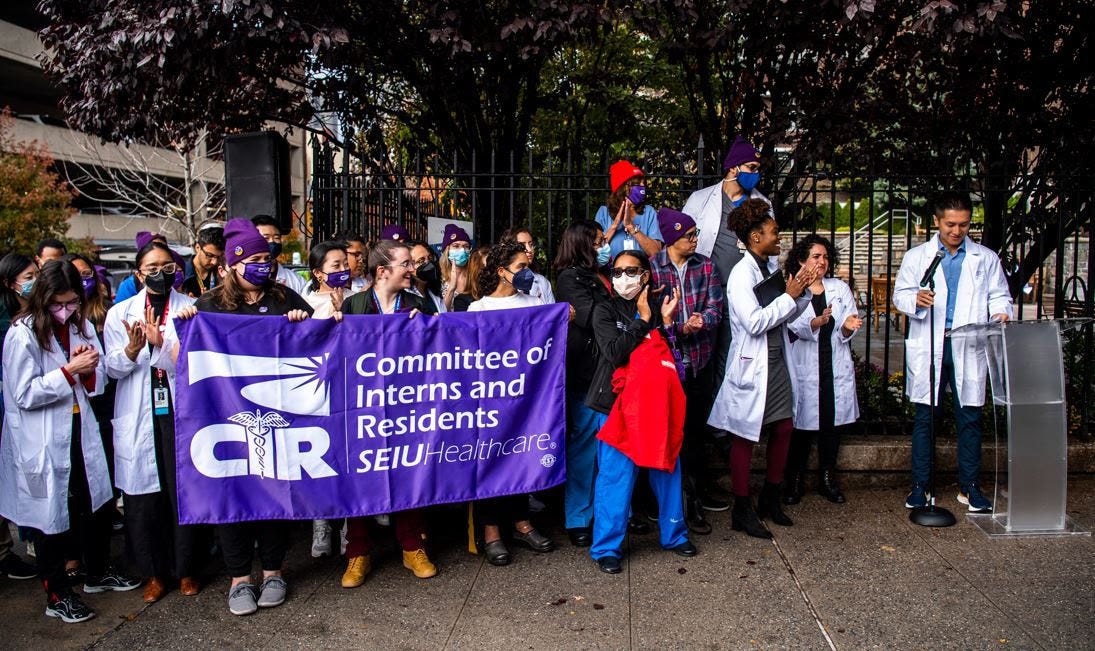Contracts Under Coercion
On debt and physician compensation with appearances by Locke, Shakespeare, Roman antiquity, and Byung-Chul Han
I didn’t think that David Graeber’s sweeping Debt: The First 5000 Years would start an inquiry into physician debt and compensation.
Some background: Debt was one of those books that haunted me (always recommended, never read). My old roommate wrote her thesis on it. Tech thinkbois reviewed it. A college friend vouched for Graeber as we celebrated his last student loan payment. We had ventured to the Hungarian Pastry Shop, a pilgrimage to Columbia’s cash-only haunt brimming with octogenarians and wannabe Granta writers. Sheltered in the bohemian elegance of mismatched furniture and stained menus, it felt appropriate to mark the moment here. The neighborhood where his debt began.
“Graeber talks about Medieval lords wiping debt to stabilize society. Instead I’m paying thousands in interest from when I was 18 because shit is rigged. Take me back to the Dark Ages. You have to read it.” After 7 years of these conspicuous nudges, I finally gave in.
Debt concerns the economic history of violence. How the body served as the locus of debt - from primordial debt (what your soul owes the gods) to arranged marriage, slavery facilitated by military empires, and indentured labor.
Graeber tempted me with a throwaway comment about physicians in ancient Rome. According to tabulae from Julius Caesar’s reign, most physicians were attached to landowning families or employed as archiatri by a polity to look after its citizens. It did not matter that antiquity respected the medical arts. Physicians and surgeons were still slaves, owned in such great numbers that Seneca compared them to armies.1
The brutal violence of selling and owning indebted people has declined but yielded to modern, sophisticated forms of coercion. 84% of med students owe a median of $200,000 (closer to $300K with current interest rates). The young physician is not ignorant to their debts compounding with minimum wage residencies, productivity requirements, non-competes, and burnout. In the words of one resident:
Call me cynical, but it’s no wonder the system is like this. Medical schools directly profit off our debt. Residency programs can then exploit our relatively cheap labor as dropping out would entail serious financial problems.
I feel like the role of student debt in perpetuating this system is felt by many but under acknowledged as no one in power has incentive to change the game.
Byung-Chul Han describes this helplessness as the new topology of violence. Individuals subject themselves to the relentless pursuit of professional success and productivity, a self-discipline to meet the demands of the system. The pressure to achieve one's goals fully justifies taking on significant medical school debt.
If only residency provided graduates any solace. A salary of $60K (translating to less than minimum wage in hours worked for the next 3-5 years), uncompromising shifts that breed chronic sleep deprivation. Some pregnant residents work right up until birth to save what they can before their paycheck goes to childcare.
In Han’s achievement age, these conditions are expected. “The stress of work has become an omnipresent aspect of contemporary life… the ideology of success glorifies self-exploitation.”2 Certainly no one expects medical school or residency to be easy but residents may be reaching their limit. From UCSF to NY’s Montefiore Medical Center, membership in the Committee of Interns and Residents (CIR) union exploded in recent years to 24,000+ physicians. This growth coincides with the FTC’s proposal against non-competes; it would invalidate restrictions on doctors seeking to practice within a geographic radius of their previous employer. Kanav Jain, co-founder and CEO of physician financial wellness startup Andwise, considers unionization and actions to curb noncompetes “long overdue.”
Locke convinced the Enlightenment generation that an employee gives his employer “but a temporary power over him, and no greater, than what is contained in the contract between ‘em.”3 But the political philosopher never anticipated the modern, totalizing regime of debt and restrictive covenants.
Today’s debt is the cloaked hangman who follows upon his pale horse, exerting a powerful influence over people's lives and desires.4 Foreboding pressure to pay off loans can lead MDs to seek out high-paying specialties like cardiology and orthopedics (average salaries of $550K/year) over lower-paying fields like pediatrics and family medicine (average salaries of $220K/year). The burden leads physicians to delay major life milestones and perform more medical errors than their peers. As Dr. James Dahle who runs the popular White Coat Investor blog explains, "People assume that because you're a doctor, you will make lots of money and any amount of student loans is OK. And that's not true."5
The psychology of debt even perverts the professional culture of medicine. Jain believes it influences the vast majority of students (~75%) to pursue health system employment over private practice. Almost everyone “leaving residency is looking for full-time hospital or health system employment…the culture of residency programs reinforces where you want to be is at a hospital.” To mimic Han: health systems and academic medical centers reign in the achievement age as the dominions of distinction, the only institutions worth accruing debt for. The appeal of independence has all but disappeared.
Hospitals skew compensation packages more and more towards productivity. In 1992, the federal government established the Resource Based Relative Value Scale, assigning a relative value unit (RVU) to every CPT code. Three components make up an RVU for each code:
Blending base salary with RVUs became the dominant compensation model. By emphasizing condition severity and procedure volume, RVUs inevitably contribute to upcoding and burnout. Perhaps unsurprisingly doctors nickname these contracts the “eat-what-you-kill” model.
I found myself struggling to understand compensation packages… what’s the difference between 6,003 RVUs for bariatric surgeons versus 7,800 RVUs for New York-based gastroenterologists? (Spoiler: it’s about the same $.) Hitting a limit self-learning with this bootleg third edition of The Physician’s First Employment Contract, I reached out to Kyle Claussen, CEO of Resolve.
Resolve helps physicians contextualize physician contracts by specialty, experience, and geography. The company hosts one of the largest public databases of physician compensation data / RVUs and offers custom contract review.
Resolve includes contract comparison on malpractice insurance/tail coverage and non-competes
Claussen acknowledges “it’s more important than ever for physicians to be aware of current fair market value because their contracts are constantly changing.” A simple shaking of hands - or durable animal skin parchment - sealed a labor agreement between two parties for Locke. In the era of market contracts, physician-employer negotiations start with a letter of intent (the term sheet). These contracts take on a unique level of granularity and complexity from mandatory telehealth and student loan payment support to IP ownership and subscription coverage for academic journals and medical societies.
Claussen encourages doctors to review their agreements holistically, beyond RVUs. “We often see physicians overlooking the softer parts of their agreements surrounding scope of practice, location of service, call schedules, time allocations, and support staffing levels. The day in and day out expectations should be structured in a way to protect the physician from being just a ‘cog in the wheel.’”
I feel for physicians - they come ready-made from the culture of residency, molded to accommodate hospital contracts. And systems know physicians conflate their value as healers with their economic value. Jain considers this a kind of noble naivete. “Most doctors think if you put in long hours, take care of patients, these values fall into place with your [economic] value. That’s not how contracts work.” One contract manager on Reddit implores physicians to stop being “so pleasant and accommodating when negotiating.” Unafraid to use their negotiation power, hospitals will go as far auto-renewing contracts without reminders.
Andwise and Resolve share a mission of financially empowering physicians with their signature contract intelligence tools. These resources are needed; only a fraction of physicians receive any financial management training in medical school/residency and remain 10 years behind their peers in terms of savings milestones.6 Jain proudly shares that Andwise runs a financial education Slack community with hundreds of MDs and trainees. The company also operates a fledgling directory of physician-specialized legal and financial professionals, and offers a product tailoring personalized education to specific financial situations. Attend (whose Chief Medical hosts the podcast Money Meets Medicine), Anatomy Financial, Doc2Doc Lending, Panacea Financial, and Plannery round up other startups offering solutions for managing physician finances.
Interviewing MDs and reading posts on Student Doctor Network reminded me of that conversation at the Hungarian Pastry Shop. “Sick to my stomach about debt,” it’s “unfair and nonsensical,” all reverberate in my friend’s voice as he cleared his final loan payment.
For Han, the achievement age demands that participants willingly accept decreased agency. Debt has a way of shaping agency in the context of what is owed, molding desires and a person's "horizon of aspiration… through its lens.”7 This manifests for physicians as the exploitation of altruism in successive refrains: punitive student loans ➡️ minimum wage residency ➡️ productivity clauses and contract non-competes.
An ecosystem programmed for collective compliance.
Debt bends physicians towards unfair choices that they learn to accept. Justified if they’re at a top hospital or framed for the good of patient care.
Unionization, federal action, and new financial empowerment products may swing the pendulum back in physician favor. Some medical schools like NYU are transitioning to tuition-free models. Modeled off Resolve’s compensation transparency tool, I wonder if any hospital might release and attract MD hires with their own contract transparency modules. Jain presses the need to take creative approaches to benefit those least likely to be proactive about their financial situation. “[N]obody WANTS to think about their debt, it's often the darkest part of someone's existence.”
For Claussen? These solutions need to be “100% for physicians.”
M. Donovan, "On the Position in Society of Physicians Amongst the Greeks and Romans," Proceedings of the Royal Irish Academy (1836-1869): 522-535.
Byung-Chul Han, Topology of Violence (MIT Press, 2018), 63-67.
John Locke, Second Treatise of Government (1690).
Revelation 5:8, King James Bible: “And I looked, and behold a pale horse: and his name that sat on him was Death, and Hell followed with him.”
Physician Leader’s A Real Education Dealing with Debt heavily references the following JAMA article on resident burnout and medical errors.
Franco Berardi, The Soul at Work (MIT Press, 2009), 141.
Much gratitude to Kyle Claussen, Kanav Jain, and the doctors/med students who shared their time with me. A special thanks to Danielle Poreh and John Capecelatro for their edits.







